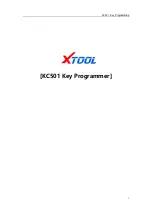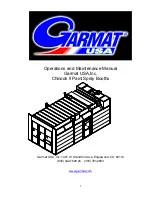
37
3.9. tEst of REsIDUAl CURREnt DEvICE
The device can be used to perform three types of test on RCDs:
a tripping test in ramp mode,
a tripping test in pulse mode,
a non-tripping test.
The test in ramp mode serves to determine the exact value of the tripping current of the RCD.
The test in pulse mode serves to determine the tripping time of the RCD.
The non-tripping test serves to check that the RCD does not trip at a current of 0.5 I
D
N
. For the test to be valid, the leakage current
must be negligible with respect to 0.5 I
D
N
and, to ensure this, all loads connected to the installation protected by the RCD that is
being tested must be disconnected.
3.9.1. DEsCRIPtIon of tHE MEAsUREMEnt PRInCIPlE
For each of the three types of test, the device starts by checking that the RCD can be tested without compromising the user’s
safety, i.e. without causing the fault voltage, U
F
, to exceed 50 V (or 25 V or 65 V according to what is defined in the SET-UP for
U
L
). The device therefore starts by generating a low current (<0.3 I
D
N
) in order to measure Z
S
, as it would for a loop impedance
measurement.
It then calculates U
F
= Z
S
x I
D
N
(or U
F
= Z
S
x 2 I
D
N
or U
F
= Z
S
x 5 I
D
N
depending on the type of test requested), which will be the
maximum voltage produced during the test. If this voltage is greater than U
L
, the device does not perform the test. The user can
then reduce the measurement current (to 0.2 I
D
N
) so that the test current combined with the leakage current present in the instal-
lation will not lead to a voltage greater than U
L
.
For a more accurate measurement of the fault voltage, we recommend planting an auxiliary rod, as for earth measurements on
live circuits. The device then measures R
A
and calculates U
F
= R
A
x I
D
N
(or U
F
= R
A
x 2 I
D
N
or U
F
= Z
S
x 5 I
D
N
depending on the type
of test requested).
Once this first part of the measurement has been made, the device goes on to the second part, which depends on the type of test.
For the ramp mode test, the device generates a sinusoidal current of which the amplitude increases gradually from 0.3 to
1.06 I
D
N
between the L and PE terminals. When the RCD opens the circuit, the device displays the exact value of the tripping
current and the tripping time. This time is an indication and may differ from the trip time in pulse mode, which is closer to the
operational reality.
For the pulse mode test, the device generates a sinusoidal current at the mains frequency, having an amplitude of I
D
N
, 2 I
D
N
or
5 I
D
N
between the L and PE terminals, lasting at most 500 ms. And it measures the time the RCD takes to open the circuit.
This time must be less than 500 ms.
For the non-tripping test, the device generates a current of 0.5 I
D
N
for one or two seconds, depending on what the user has
programmed. Normally, the tripping must not trip.
In the ramp and pulse mode tests, if the RCD does not trip, the device sends a current pulse between the L and N terminals. If
the RCD trips, it is because it was incorrectly installed (N and PE reversed).
3.9.2. PERfoRMInG A tEst In RAMP MoDE
SET UP
OFF
Set the switch to RCD
.
Connect the measuring cable to the device, then to a socket outlet included in the circuit
protected by the RCD to be tested.
At the time of connection, the device detects the positions of the phase (L) and
of neutral (N) with respect to the protective conductor (PE) and displays them. If
necessary, it then automatically switches the L and N terminals so that the test
can be done without modifying the connections of the terminals.
Summary of Contents for C.A 6116
Page 1: ...C A6116 Installation TESTER E N G L I S H User s manual...
Page 95: ...95...
















































